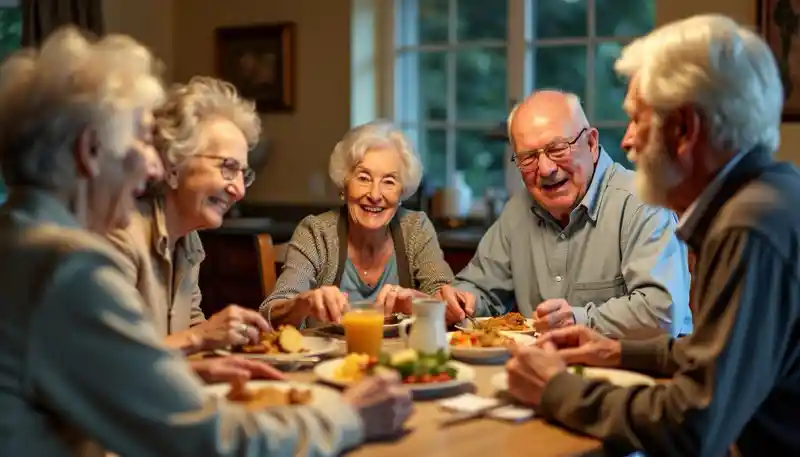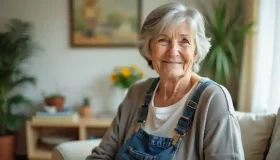Are you worried about feeling lonely as you age? Senior cohousing is a new way to live that’s gaining popularity. These communities offer private homes with shared spaces and activities.
You’ll learn how these villages can help you stay connected and supported in your golden years. Read on to discover a revolutionary approach to senior living.
Key Takeaways
- Seniors-only cohousing communities offer private homes with shared spaces, fostering connections while respecting personal privacy.
- ElderSpirit in Abingdon, Virginia has 29 units, including affordable rentals from $300-$484 and homes sold for $90,000-$113,200.
- Regular social activities and communal dining, like Silver Sage’s twice-monthly shared meals, help build strong social bonds among residents.
- These communities combat loneliness in older adults, which affects 40% of seniors and can reduce life expectancy by up to 10 years, according to a UCSF study.
- Residents support each other with daily tasks and health needs, as seen at ElderSpirit where neighbors help with grocery shopping and medical appointments.
Key Features of Seniors-Only Cohousing Communities

Seniors-only cohousing communities offer a unique living setup. They blend private homes with shared spaces, creating a close-knit neighborhood feel.
Private residences with shared community spaces
You’ll find a unique blend of privacy and community in seniors-only cohousing. Your home is yours alone, but you share spaces with neighbors. These shared areas often include a “common house” with a kitchen, dining room, and gathering space.
This setup fosters connections while respecting your need for personal space.
ElderSpirit in Abingdon, Virginia offers a great example of this living style. The community has 29 units, with 16 being federally subsidized rentals. These affordable options cost $300-$350 for one-bedroom and $484 for two-bedroom units.
The other homes sold for $90,000 to $113,200. This mix allows for a diverse group of residents to enjoy the benefits of communal living.
Organized social activities and communal dining
In seniors-only cohousing communities, organized social activities and communal dining form the heart of daily life. You’ll find regular events that bring neighbors together, fostering a strong sense of community.
For example, Silver Sage residents gather twice a month for shared meals. These gatherings take place in various locations, such as the local senior center or even on the scenic Virginia Creeper Trail.
These communal meals do more than fill stomachs; they nourish social bonds and team spirit among residents.
Beyond meals, these communities offer a range of activities to keep you engaged and connected. Monthly meetings at Silver Sage focus on important topics like aging and preparing for health challenges.
You can also join virtual Q&A sessions about seniors in cohousing, held on the 20th of each month. These events provide valuable information and support, helping you navigate the unique aspects of this living arrangement.
The CohoUS Seniors in Cohousing Committee offers additional resources to enhance your experience in these intentional communities. Next, let’s explore the benefits of living in a seniors-only cohousing community.
Benefits of Living in a Seniors-Only Cohousing Community
Seniors-only cohousing offers a unique way to age with dignity and joy. You’ll find a strong sense of belonging and purpose in these vibrant communities.
Enhanced social interaction to combat loneliness
You’ll find a cure for loneliness in seniors-only cohousing communities. These places offer many chances to connect with others. You can join group meals, clubs, and activities. This setup helps fight the isolation that often comes with aging.
A study by UCSF found that 40% of older adults feel lonely. This feeling can cut life expectancy by up to 10 years.
Cohousing gives you a built-in support system. You’ll have neighbors who look out for each other. This network can help with daily tasks and health needs. Research shows that living in these communities boosts happiness.
It also makes you feel safer. By joining a cohousing community, you can enjoy your golden years with friends close by.
Supportive network for health and daily living needs
Building on the social connections, seniors-only cohousing communities offer a strong support system for health and daily needs. In these communities, neighbors look out for each other, providing help when needed.
For example, at ElderSpirit, residents assist with tasks like grocery shopping or rides to doctor appointments. This support proves invaluable in times of crisis, as seen with Clare Marie Ackroyd, 62, who received help after breaking her shoulder.
Cohousing communities foster a culture of care that extends beyond basic assistance. Residents often share meals, reducing the burden of cooking for one. They also organize group activities that promote physical and mental health.
This supportive environment allows seniors to age in place comfortably, maintaining independence while having access to help when needed. The shared resources in these communities can also lead to lower healthcare costs for residents.
Conclusion
Seniors-only villages offer a fresh take on retirement living. You’ll find a vibrant community where you can thrive and connect with others. These spaces blend private homes with shared areas, creating a unique balance.
Your golden years can be filled with purpose, friendship, and support. Consider exploring this revolutionary housing option for a fulfilling retirement experience.
FAQs
1. What is a seniors-only village?
A seniors-only village is an intentional community designed for aging in place. It offers independent living for older adults who want to avoid social isolation. These communities focus on decision-making that supports senior-care needs.
2. How does cohousing differ from assisted living?
Cohousing allows seniors to maintain independence while fostering community. Unlike assisted living, residents in cohousing make collective choices about their environment. This model, popularized by Charles Durrett and Kathryn McCamant, promotes active aging.
3. Can intergenerational cohousing benefit seniors?
Yes, intergenerational cohousing can reduce loneliness among older adults. It creates opportunities for seniors to interact with younger people, potentially lowering risks of dementia. This approach mirrors successful models used by Swedes.
4. How do these communities address end-of-life concerns?
Seniors-only villages often have systems in place to support residents through end-of-life stages. They may offer resources for managing health issues like obesity or antibiotic-resistant infections. The community structure provides emotional support during these challenging times.
5. Are there any drawbacks to seniors-only villages?
While these communities combat social isolation, they may limit exposure to diverse age groups. Some critics argue this could impact seniors’ connections with society at large. However, proponents say the benefits of tailored support outweigh potential drawbacks.






